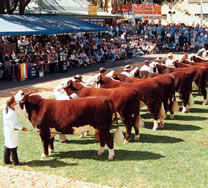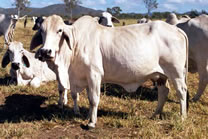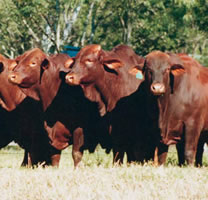Crossbreeding
Crossbreeding Beef Cattle
Crossbreeding is a relatively recent phenomenon in Australia, developing in southern areas with the introduction of European breeds and in the north with the introduction of Bos indicus cattle. The easy production gains available through hybrid vigour are difficult for commercial cattlemen to ignore and the practice has become more widespread. There has emerged in Australia something of a balance between cattlemen who successfully maintain purebred herds, and those who have adopted crossbreeding techniques.

Crossbreeding has been a valuable tool for cattlemen wishing to produce cattle that exhibit the specific traits required in a particular situation and also provides greater flexibility by expanding the available gene pool. An example of its successful use in Australia is where a northern producer maintains a breeding base of pure Brahman cows for their climatic adaptability traits, but introduces a British breed bull as a terminal cross for the greater market acceptance of the progeny for feedlot fattening.
Other, more complex, crossbreeding systems have been adopted by some producers who use multiple breeds with the aim of stabilising a second or third cross composite herd. The aim here is to stabilise the genetic base while still achieving significant heterosis . In other words, they aim to maintain the ease of purebred breeding, but with the benefit of hybrid vigour. These systems can be very successful but are quite complex to develop and implement.

Crossbreeding has never been as popular in Australia as in the US and Britain. Most of the Australian crossbreeding has been geared towards the development of new, composite breeds. However, there has been a recent and interesting move into two, three and even four breed crossing, particularly in the southern states. Typically, these crossbreeding enterprises use British breed cows as the base, mated to bulls of European breeds for high fertility and calving rates and good milking traits. The female progeny are then crossed with breeds of high growth rate and preferred carcase quality traits.
A simpler system uses a base British or European breed cow and mates it to one of the favoured carcase breeds such as the Angus, Murray Grey or Wagyu. Their progeny are sold as prime young pasture
fed steers for the domestic market, or for on-sale as fatteners for feedlots. The F1 heifers from these matings are often sold as potential breeders.
These crossbreeding programs have resulted in the evolution of new crossbred composites designed to include the best traits of a number of breeds, combined with the vibrancy of hybrid vigour. Early versions were the Beefmaker and Simford, but the more complex composites such as the Shaver Beefblend and the Excellerator are more popular today.
Crossbreeding has also been a major element in the mid 1990s boom in northern live cattle exports. The trade has brought new life to the beef cattle industry of northern Australia, providing real competition and better prices to isolated areas previously threatened by abattoir closures. Historically, beef producers in the north turned off fully grown bullocks at least four years old. With the live cattle trade, younger, lighter cattle are required with a consequent greater emphasis on the productivity and fertility of cows, and the growth characteristics of their progeny. With increased income from live exports, cattlemen have been better positioned to improve their livestock and property. As a result, local economies have benefited from large amounts of money spent on infrastructure and lifestyle improvements.
Significant for industry has been the investment in good Brahman bulls to upgrade the old British breed-based cattle herds.
These Brahman, Brahman crosses and other tropical breeds of cattle are the backbone of the live cattle export industry. Markets like Indonesia, the Philippines, Malaysia and Brunei are hot and humid and require cattle that will thrive, grow and fatten in these conditions. The Bos indicus cattle fill this role admirably and as a result, ensure the long-term viability of the northern cattle industry.
Exports to Middle Eastern markets tend to be heavy animals ready for slaughter, so their time in the importer’s feedlot is limited. Although cattle with some Bos indicus blood perform better in Middle Eastern conditions, customer demand still favours the Bos taurus type. These heavy, finished cattle are typically bred and exported from the southern regions of Australia.
Exports to Japanese feedlots require yearling steers that have the ability to respond to the heavy Japanese grain rations and produce carcases that are well marbled. This trade is almost exclusively sourced from Bos taurus breeds, particularly the Murray Grey, Angus and increasingly Australian bred Wagyu crosses.
